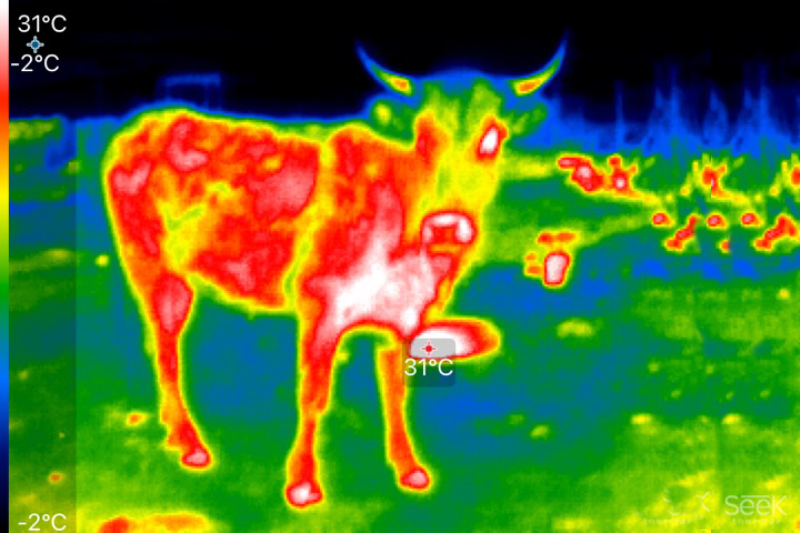Diseased livestock: infrared system’s early warning
17 September 2020 | Story Helen Swingler. Voice Lerato Molale. Read time 7 min.
Like humans, animals are threatened by deadly pandemics that spread quickly and, in the case of commercial livestock, decimate herds and flocks. But an inexpensive early warning diagnostic tool developed by the University of Cape Town’s (UCT) Professor Amit Mishra and start-up company 3DIMO holds hope for small- and medium-scale livestock farmers, many of whom are black women.
The Thola infrared imaging tool is being developed by local black economic empowerment start-up company 3DIMO. It is in the final stages of phase one of a pilot project involving several emerging farmers in Thaba ’Nchu in the Free State.
A basic infrared camera (around one third of the size of a smartphone) can be mounted on a smartphone or, for larger areas and numbers, the images can be taken using bigger infrared cameras mounted on drones.
The infrared camera measures the heat signature of each point of the animal in the field of view. This provides useful information; for example, a higher temperature on a foreleg could signal inflammation or some other malaise.
“Different diseases have different signatures,” said Professor Mishra. “Not all diseases are detectable, but the temperature of the hoofs, and some other parts of the animals, for example, has been shown to be very useful in detecting common diseases like foot-and-mouth disease.”

This data is fed into the Thola platform, where the artificial intelligence (AI) algorithms are designed to look for abnormalities. A network of monitoring devices can be built, integrating information across critical livestock areas. The archive of data is also searchable.
Tags are used to identify individual animals in a herd or flock. The team, which includes a former UCT electrical engineering postgraduate, is also working on image-based identification using machine learning and AI.
“As the image platform – the phone or the drone – can also take optical images, we would be using both the optical image and the [infrared] image,” said Mishra.
This part of the development has been one of their biggest challenges.
The data can be used for vital stock monitoring and management. In 2019 South Africa was the continent’s largest beef and dairy producer, said Mishra.
“The demand for meat and dairy products has ignited growth in new farmers and increased herd sizes.”
“With the growth in meat consumption at an all-time high, the demand for meat and dairy products has ignited growth in new farmers and increased herd sizes.”
The flip side is that larger herds mean that viral infection can go undetected in the early stages, spreading rapidly. In the past five years, unprecedented livestock deaths have created a decline of 15 to 26% in revenue generated from the country’s livestock production and export.
Early warning signals
Early warning is thus vital. In 2013 the porcine epidemic diarrhoea virus (a coronavirus that infects the cells lining the small intestine of a pig) killed almost eight million pigs in the United States. Last year, an outbreak of foot-and-mouth disease on South African cattle farms severely dented exports in one of the country’s biggest economic sectors.
“One in five farm animals is being lost to disease, and this reverberates far beyond the animal,” said 3DIMO’s chief executive officer, Nneile Nkholise. It affects almost one billion people worldwide who rely on meat, milk and egg production.
The cost can be staggering, Nkholise added. In the past 20 years, six international outbreaks of disease caused economic losses of US$80 billion. And for every 20 farm animals lost, one job is at risk.
“Addressing biosecurity and food security in South Africa and the continent has critical and lasting social and economic benefits,” said Nkholise. “But long-term solutions can’t lie solely with government. We need an innovative, accessible and affordable lasting approach to protect farm animal welfare.”
Shortage of diagnostic tools
Mishra said that they started with the idea of the early warning of viruses in farm animals to help prevent future pandemics. However, very soon they realised that there’s an acute shortage of diagnostic tools for most small- and medium-scale farmers.
“We also found that many of the small-scale farmers are black women.”
“We also found that many of the small-scale farmers are black women. Serendipitously, we may have found a niche with major scope to create an impact.”
This is where their focus lies.
But there are still unknowns. The feedback and experiences of emerging farmers involved in the first pilot phase will provide useful insights about the technology, which will help the team to develop simplified methods of data analysis, communication and visualisation.
“The testing was not only about the tech but also to test client receptivity and demand within a controlled environment,” said Nkholise. “The most important decision we took as a team was to co-develop our livestock health management solution with farmers, allowing them to share their experiences and difficulties.”
Business in a box
Mishra hopes that this will help refine their system, prove commercial viability and related socio-economic impact. The plan is to develop two models using off-the-shelf infrared cameras and drones – one for commercial farms and another for smallholder farmers.
The benefits include the monthly scanning of farm animals, detailed reports that can be accessed on a user dashboard, training and access to partner animal health specialists.
They are also working towards a third option: a business in a box for use on smallholdings.
“This can be used according to an Uber-like model, where owners of the [business in a box] can be outsourced.”
“This can be used according to an Uber-like model, where owners of the [business in a box] can be outsourced to collect data at different farms and get paid for it. So, there’s a job creation element too.”
It has been a joy to work with the emerging farmers, Nkholise added. “They offer a wealth of insights on livestock farming we had no idea of. It has been interesting to experience their love of farming and its contribution to the economy.”
Is the technology applicable to humans?
It is already being used at airports to detect individuals’ temperatures for detecting severe acute respiratory syndrome (SARS) and COVID-19, said Nkholise.
However, it’s always more challenging to work on human subjects.
“Humans move around a lot, and it’s challenging to employ effective tracing. With animals it’s easy because most are confined in one location.”
 This work is licensed under a Creative Commons Attribution-NoDerivatives 4.0 International License.
This work is licensed under a Creative Commons Attribution-NoDerivatives 4.0 International License.
Please view the republishing articles page for more information.
Listen to the news
The stories in this selection include an audio recording for your listening convenience.











































































































































































































































































































































































































